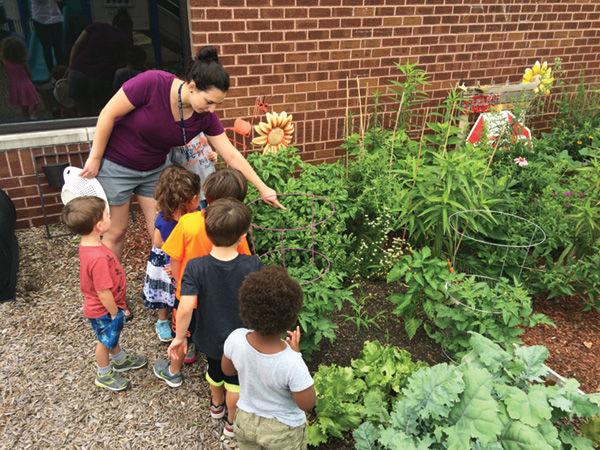Shaare Emeth preschool certified as ‘Nature Explore’ classroom
Published July 27, 2016
Despite the oppressive heat and humidity, the eight toddlers who file outdoors at the Shirlee Green Preschool sit at attention as teacher Abby Bennett prepares to read to them from a book on mitzvot.
“We’re going to go over to the garden,” she explains, “but first I want to talk about something called doing a mitzvah. Anyone know what a mitzvah is?”
The preschool itself certainly knows and the play/learning area in which these youngsters sit is a good deed for both the Earth and the children who occupy it. Known as the outdoor kitah or “classroom,” it was certified just this month by the Nebraska-based Nature Explore program, an initiative that aims to connect children to the natural world.
ADVERTISEMENT
Shirlee Green is the first Jewish preschool in the area to receive the honor and one of only 15 institutions in the entire state to be recognized. Participants can apply for certification for an outdoor classroom by incorporating various principles of Nature Explore including the use of natural materials sourced from the local area and an abundance of live plants.
Certified classrooms are divided into different clearly defined activity areas to engage youngsters. Ten areas blanket the preschool at Congregation Shaare Emeth including a “music area,” a “climbing area” and a “messy area” where children can construct things out of various materials including pine cones and wood chips.
Reused or recycled materials abound throughout the space. During Bennett’s explanation of mitzvot, the children sit on repurposed wooden pallets. Reused logs line another area and an old metal rowboat sits as the centerpiece of the “dramatic” area where children enjoy play acting. Even the signage in English and Hebrew is made from old reused pieces of wood.
ADVERTISEMENT
“With the table that you see in the art area, we chiseled out the center and inserted a slate and they use it for chalk drawings,” said Karen Lucy, director of early childhood engagement.
For Lucy, the project has been a labor of love since she began here three years ago. Now, with the certification, it has all come together – from the giant flower-shaped shade canopy in the movement area surrounded by tiger grass and miniature peach trees to the sand area where natural improvements continue to advance with the climbing plants.
“We had an existing sandbox and we tried to get a little bit more creative,” she said. “We’re also growing honeysuckle so we’re hoping that grows up the wall.”
One popular part of the grounds is the mitzvah garden where green peppers and basil mix with kale and broccoli. More than that, the greenery isn’t for show. Much of it is eaten in dishes prepared at the temple. There is also a composter on-site.
“The cucumbers and pumpkins have already taken over the snap pea trellis,” Lucy observed, noting that the peas have already been harvested.
She said that the kitah environment tends to make the kids more culinarily adventurous in selecting healthy dishes.
“If a parent introduces it, they may have resistance,” she said of new foods. “Here…being in a group, it is introduced in a fun way so they love it.”
It also sharpens the youngsters’ gardening skills. An unused area of dirt sits at the center of the garden scattered with small hoes and trowels.
“The middle bed we left intentionally for digging so when the little ones start to come out here, they can start using those gross and fine motor skills here before experimenting on the garden,” she said.
She said the nearby boat, which she acquired from a neighbor, has been especially popular.
“It is to make the children reach out of their comfort zone and be as creative and imaginative as possible,” she noted.
Lucy said finding decorative and repurposed materials was easier than one might think. Often local shops wanted to help.
“A variety of people – as soon as you start asking – they are so generous,” she said. “Sometimes they’ll just say ‘Take this. We love what you are doing.’”
Getting certification took some time however. Nature Explore, run by the Arbor Day and Dimensions Educational Research foundations, requires attendance at a workshop, adherence to various design principles and the use of certain types of themed areas.
“They want to make sure that not only do you maintain safe standards but that you are practical as you develop your idea,” she said.
Amy Leimbach, a teacher at the preschool, said that the kids like the way the outdoor classroom is arranged.
“It’s amazing. The children have access to things that they don’t at other preschools or daycare facilities,” she said. “They love being outside. It brings them a sense of calm and reassurance and freedom that they don’t get otherwise.”
Many, including Leimbach own son, enjoy exploring the old metal boat.
“They play pirate ship and they get to be captains and sailors,” she said. “The level of pretend play they get out there is really neat to see and to watch develop.”

















